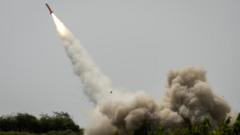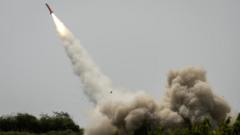As the conflict between Russia and Ukraine continues to intensify, the United States has made significant adjustments to its military aid strategies aimed at bolstering Ukrainian defenses. Following President Trump's recent decision to sell arms to NATO countries for subsequent transfer to Ukraine, this marks a notable turn in U.S. foreign policy towards the ongoing war.
Shifts in U.S. Military Aid to Ukraine Amid Ongoing Conflict

Shifts in U.S. Military Aid to Ukraine Amid Ongoing Conflict
The U.S. adjusts its military support strategies for Ukraine, including new arms sales to NATO allies for redistribution.
In the wake of Russia's invasion in 2022, the Biden administration has been particularly active, providing an estimated $33.8 billion in weaponry through the Pentagon's reserves and an additional $33.2 billion directly to bolster Ukraine’s defense procurement from American manufacturers. The U.S. had commenced military assistance to Ukraine well before the current conflict, initially supplying nonlethal aid post-2014 invasion by Russia and gradually evolving to include advanced weaponry through a series of drawdown shipments.
The arms supply strategies include various types of military assistance via the Pentagon’s presidential drawdown authority, enabling quick transfer of arms from U.S. stockpile to Ukraine's frontlines. Meanwhile, through the Ukraine Security Assistance Initiative, funds are allocated for direct purchases from the U.S. defense industry, which allows Ukraine access to a sustained supply chain albeit on a longer timeline.
The latest announcement from Trump introduces a plan to sell arms to European nations, enabling them to either equip Ukraine directly or replace equipment they lend to the Ukrainian forces. Historically, the U.S. has provided a diverse array of military assets including tanks, armored vehicles, air defense systems, and artillery, while also collaborating with approximately 50 allied nations to provide additional military resources to Ukraine.
Among Ukraine's critical needs in this ongoing struggle is adequate air defense capabilities; a requirement highlighted repeatedly since the outbreak of war. In December 2022, President Biden approved the transfer of advanced systems like the Patriot missile battery, and further support may follow as Trump signaled readiness to provide even more such capabilities.
This evolving narrative of military aid reflects the adaptability of U.S. strategy in response to real-time developments in the Ukrainian struggle for sovereignty against Russian aggression. As the situation unfolds, both the nature and distribution of aid will likely continue to play a pivotal role in the conflict's trajectory.
John Ismay, reporting from Washington, is a noted journalist with a background in military service as an explosive ordnance disposal officer in the U.S. Navy.
The arms supply strategies include various types of military assistance via the Pentagon’s presidential drawdown authority, enabling quick transfer of arms from U.S. stockpile to Ukraine's frontlines. Meanwhile, through the Ukraine Security Assistance Initiative, funds are allocated for direct purchases from the U.S. defense industry, which allows Ukraine access to a sustained supply chain albeit on a longer timeline.
The latest announcement from Trump introduces a plan to sell arms to European nations, enabling them to either equip Ukraine directly or replace equipment they lend to the Ukrainian forces. Historically, the U.S. has provided a diverse array of military assets including tanks, armored vehicles, air defense systems, and artillery, while also collaborating with approximately 50 allied nations to provide additional military resources to Ukraine.
Among Ukraine's critical needs in this ongoing struggle is adequate air defense capabilities; a requirement highlighted repeatedly since the outbreak of war. In December 2022, President Biden approved the transfer of advanced systems like the Patriot missile battery, and further support may follow as Trump signaled readiness to provide even more such capabilities.
This evolving narrative of military aid reflects the adaptability of U.S. strategy in response to real-time developments in the Ukrainian struggle for sovereignty against Russian aggression. As the situation unfolds, both the nature and distribution of aid will likely continue to play a pivotal role in the conflict's trajectory.
John Ismay, reporting from Washington, is a noted journalist with a background in military service as an explosive ordnance disposal officer in the U.S. Navy.





















